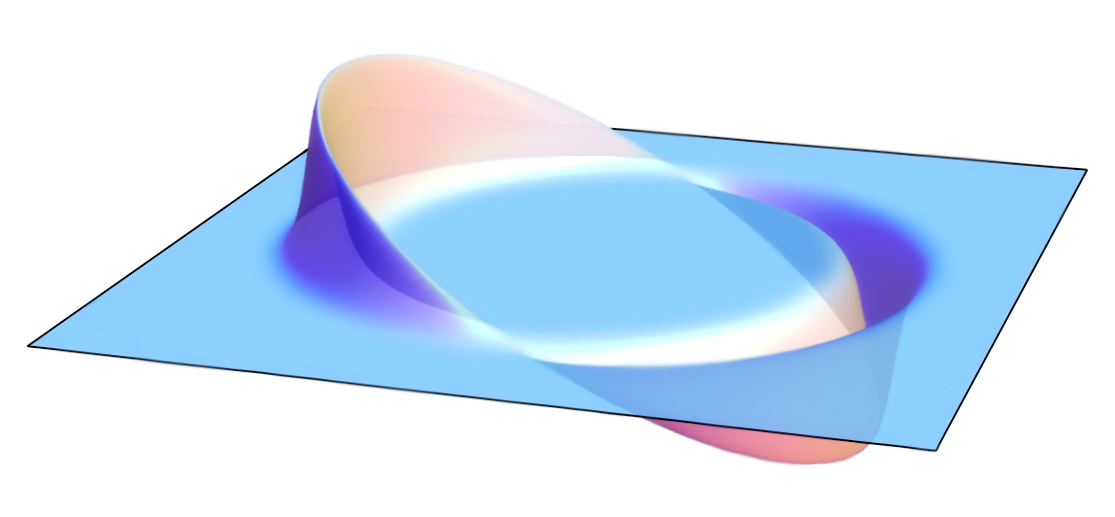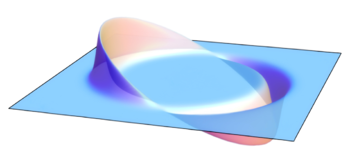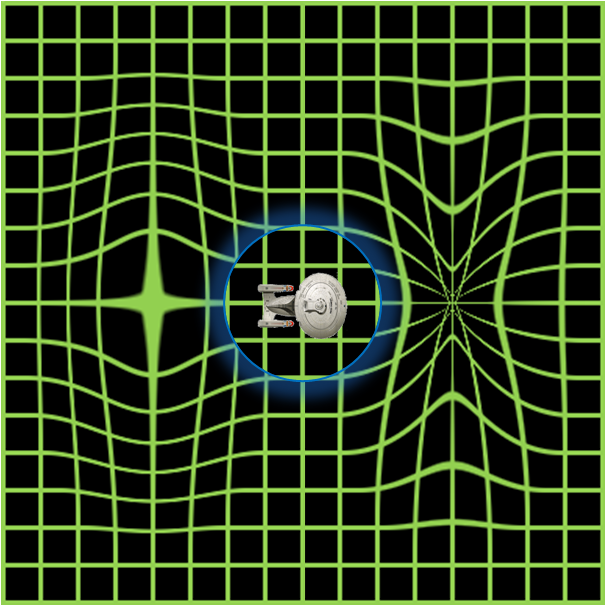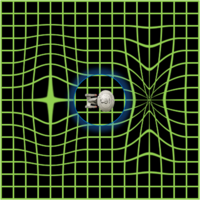.....::: Time Travel Research Center © 2005 Cetin BAL - GSM:+90 05366063183- Turkey / Denizli ::.....
Alcubierre drive
The Alcubierre metric, also known as the Alcubierre drive or Warp Drive, is a speculative mathematical model of a spacetime exhibiting features reminiscent of the fictional "warp drive" from Star Trek, which can travel "Faster-than-light" .

In 1994, the Mexican physicist Miguel Alcubierre proposed in the Journal of Classical and Quantum Gravity a method of stretching space in a wave which would in theory cause the fabric of space ahead of a spacecraft to contract and the space behind it to expand. The ship would ride this wave inside a region known as a warp bubble of flat space. Since the ship is not moving within this bubble, but carried along as the region itself moves, conventional relativistic effects such as time dilation do not apply in the way they would in the case of a ship moving at high velocity through flat spacetime. Also, this method of travel does not actually involve moving faster than light in a local sense, since a light beam within the bubble would still always move faster than the ship; it is only "faster than light" in the sense that, thanks to the contraction of the space in front of it, the ship could reach its destination faster than a light beam restricted to travelling outside the warp bubble. Thus, the Alcubierre drive does not contradict the conventional claim that relativity forbids a slower-than-light object to accelerate to faster-than-light speeds. However, there are no known methods to create such a warp bubble in a region that does not already contain one, or to leave the bubble once inside it, so the Alcubierre drive remains a theoretical concept at this time.
Mathematics of the Alcubierre drive

Using the 3+1 formalism of general relativity, the spacetime is described by a foliation of space-like hypersurfaces of constant coordinate time t. The general form of the Alcubierre metric is:
![]()
where α is the lapse function that gives the interval of proper time between nearby hypersurfaces, βi is the shift vector that relates the spatial coordinate systems on different hypersurfaces and γij is a positive definite metric on each of the hypersurfaces. The particular form that Alcubierre studied (1994) is defined by:
![]()
- βy = βz = 0
- γij = δij
where
![]()
![]()
and
![]()
with R > 0 and σ > 0 arbitrary parameters. With this particular form of the metric, it can be shown that the energy density measured by observers whose 4-velocity is normal to the hypersurfaces is given by

where g is the determinant of the metric tensor. Thus, as the energy density is negative, one needs exotic matter to travel faster than the speed of light' (Alcubierre, 1994). The existence of exotic matter is not theoretically ruled out, the Casimir effect and the Accelerating Universe both lends support to the proposed existence of such matter. However, generating enough exotic matter and sustaining it to perform feats such as faster-than-light travel (and also to keep open the 'throat' of a wormhole) is thought to be impractical. Low (1999) has argued that within the context of general relativity, it is impossible to construct a warp drive in the absence of exotic matter. It is generally believed that a consistent theory of quantum gravity will resolve such issues once and for all.
Alcubierre Metric
The Alcubierre Metric defines the so-called warp drive spacetime. This is a Lorentzian manifold which, if interpreted in the context of general relativity, exhibits features reminiscent of the warp drive from Star Trek: a warp bubble appears in previously flat spacetime and moves off at effectively superluminal speed. Inhabitants of the bubble feel no inertial effects. The object(s) within the bubble are not moving (locally) faster than light, instead, the space around them shifts so that the object(s) arrives at its destination faster than light would in normal space[1].
Mathematical representation
The Alcubierre metric may be written where
![]()
and
![]()
Alcubierre chose a specific form for the function f, but other choices give a simpler spacetime exhibiting the desired "warp drive" effects more clearly and simply.
Physics of the Alcubierre drive
For those familiar with the effects of special relativity, such as Lorentz contraction and time dilation, the Alcubierre metric has some apparently peculiar aspects. In particular, Alcubierre has shown that even when the ship is accelerating, it travels on a free-fall geodesic. In other words, a ship using the warp to accelerate and decelerate is always in free fall, and the crew would experience no accelerational g-forces. Enormous tidal forces would be present near the edges of the flat-space volume because of the large space curvature there, but by suitable specification of the metric, these would be made very small within the volume occupied by the ship (Alcubierre, 1994).

The original warp drive metric, and simple variants of it, happen to have
the ADM form which is often used in discussing the initial value formulation
of general relativity. This may explain the widespread misconception that
this spacetime is a solution of the field equation of general relativity.
Metrics in ADM form are adapted to a certain family of inertial observers,
but these observers are not really physically distinguished from other such
families. Alcubierre interpreted his "warp bubble" in terms of a contraction
of "space" ahead of the bubble and an expansion behind. But this
interpretation might be misleading (Natario, 2002), since the contraction
and expansion actually refers to the relative motion of nearby members of
the family of ADM observers.
In general relativity, one often first specifies a plausible distribution of
matter and energy, and then finds the geometry of the spacetime associated
with it; but it is also possible to run the Einstein field equations in the
other direction, first specifying a metric and then finding the energy-momentum
tensor associated with it, and this is what Alcubierre did in building his
metric. This practice means that the solution can violate various energy
conditions and require exotic matter. The need for exotic matter leads to
questions about whether it is actually possible to find a way to distribute
the matter in an initial spacetime which lacks a "warp bubble" in such a way
that the bubble will be created at a later time. Yet another problem is that
according to Krasnikov (1998) it would be impossible to generate the bubble
without being able to force the exotic matter to move at locally FTL speeds,
which would require the existence of tachyons. Some methods have been
suggested which would avoid the problem of tachyonic motion, but would
probably generate a naked singularity at the front of the bubble. [2][3]
The Alcubierre drive and science fiction
A warp field as in Star Trek.

Note that faster-than-light travel is often used in science fiction to
denote a wide variety of imaginary propulsion methods, most of which have
nothing to do with the Alcubierre drive or any other physical theory.
Star Trek fans claim that, in Star Trek, the Alcubierre theory has largely
been accepted due to the similarity of the appropriate terms, in order to
explain the apparent breaking of the laws of physics in most of the series.[citation
needed] In fact, the physics of warp drive in Star Trek have never been
defined specifically onscreen and none of the "technical manuals" based on
the show has made any reference to Dr. Alcubierre's theory.
In a 1978 production memo, Dr. Jesco von Puttkamer, technical advisor for
Star Trek: The Motion Picture, proposed a model of warp drive which bears
some striking similarities to Dr. Alcubierre's later theory, employing the
same principle of a distortion in spacetime moving a ship faster than light
inside a pocket of spacetime within it. (The memo is reprinted on pp. 153-4
of the book The Making of Star Trek: The Motion Picture.)
However, later Star Trek technical advisors did not follow this model, and
modern Star Trek productions tend to follow a warp-drive model based on the
use of "subspace" as an alternate dimensional realm through which a ship may
travel at hyperlight speeds, analogous to the use of hyperspace in much
science fiction. However, the specifics remain vague enough that some
consider it possible to reconcile Star Trek warp drive with the Alcubierre
theory (for example, see Aftermath by Christopher L. Bennett in the
Starfleet Corps of Engineers Ebook series). Another, more recent book called
Warp Speed by Dr. Travis S. Taylor delves more into detail about the
Alcubierre theory, as well as using it as the basis for the entire book.
Although it precedes Alcubierre drive, the anime version of Captain Future
featured a similar mechanism, called undulating mode.
Alcubierre drive theory is also mentioned in Orbiter, a graphic novel by
Warren Ellis.
Stephen Baxter mentions Alcubierre drive theory in his short story
collection 'Vacuum Diagrams'.
Ian Douglas uses Alcubierre drive theory in his Inheritance Trilogy novels.
Criticisms
- The pilot inside the bubble is causally disconnected with its walls and cannot carry out any action outside the bubble. However, it is necessary to place devices along the route in advance and, since the pilot cannot do this while "in transit", the bubble cannot be used for the first faster-than-light trip to a distant star. In other words, to travel to Vega (which is 26 light-years from the Earth) one first has to arrange everything so that the bubble moving toward Vega with a superluminal velocity would appear and these arrangements will always take more than 26 years (Krasnikov, 1998).
- Significant problems with the metric of this form stem from the fact that all known warp drive spacetimes violate various energy conditions. It is true that certain experimentally verified quantum phenomena, such as the Casimir effect, when described in the context of the quantum field theories, lead to stress-energy tensors which also violate the energy conditions and so one might hope that Alcubierre type warp drives could perhaps be physically realized by clever engineering taking advantage of such quantum effects. However, if certain quantum inequalities conjectured by Ford and Roman hold, then the energy requirements for some warp drives may be absurdly gigantic, e.g. the energy -1067g might be required to transport a small spaceship across the Milky Way galaxy. Counterarguments to these apparent problems have been offered (Krasnikov, 2003), but not everyone is convinced they can be overcome.
Expansion on the work of Alcubierre
- Chris Van Den Broeck tried to address potential issues in a 1999 paper also published in Classical and Quantum Gravity. By contracting the 3+1 dimensional surface area of the 'bubble' being transported by the drive, while at the same time expanding 3 dimensional the volume contained inside, Van Den Broeck was able to reduce the total energy needed to transport small atoms to less than 3 solar masses. Later by slightly modifying the Van Den Broeck metric Krasnikov reduced the necessary total amount of negative energy to a few milligrams[4].
References
- Lobo, Francisco S. N.; & Visser, Matt (2004). "Fundamental limitations on 'warp drive' spacetimes". Class. Quant. Grav. 21: 5871-5892. See also the eprint. arXiv. Retrieved on 23 June, 2005.
- Natario, Jose (2002). "Warp drive with zero expansion". Class. Quant. Grav. 19: 1157-1166. See also the eprint. arXiv. Retrieved on 23 June, 2005.
- Broeck, Chris Van Den (1999). "A `warp drive' with more reasonable total energy requirements". Class. Quant. Grav. 16: 3973-3979. See also the eprint. arXiv. Retrieved on 23 June, 2005.
- Low, Robert J. (1999). "Speed Limits in General Relativity". Class. Quant. Grav. 16: 543-549. See also the eprint version. arXiv. Retrieved on 30 June, 2005.
- Hiscock, William A. (1997). "Quantum effects in the Alcubierre warp drive spacetime". Class. Quant. Grav. 14: L183-L188. See also the eprint. arXiv. Retrieved on 23 June, 2005.
- Pfenning, Michael J.; Ford, L. H. (1997). "The unphysical nature of 'Warp Drive'". Class. Quant. Grav. 14: 1743-1751. See also the eprint. arXiv. Retrieved on 23 June, 2005.
- Alcubierre, Miguel (1994). "The warp drive: hyper-fast travel within general relativity". Class. Quant. Grav. 11: L73-L77. See also the eprint version. arXiv. Retrieved on 23 June, 2005., and also at iop.org
- S. Krasnikov (1998). "Hyper-fast travel in general relativity". Physical Review D 57: 4760. See also the eprint version. arXiv.
- L. H. Ford and T. A. Roman (1996). "Quantum field theory constrains traversable wormhole geometries". Physical Review D: 5496. See also the eprint. arXiv.
- S. Krasnikov (2003). "The quantum inequalities do not forbid spacetime shortcuts". Physical Review D 67: 104013. See also the eprint version. arXiv.
- Berry, Adrian (1999). The Giant Leap: Mankind Heads for the Stars. Headline. ISBN 0-7472-7565-3. Apparently a popular book by a science writer, on space travel in general.
- T. S. Taylor, T. C. Powell, "Current Status of Metric Engineering with Implications for the Warp Drive," AIAA-2003-4991 39th AIAA/ASME/SAE/ASEE Joint Propulsion Conference and Exhibit, Huntsville, Alabama, July 20-23, 2003
Hiçbir yazı/ resim izinsiz olarak kullanılamaz!! Telif hakları uyarınca bu bir suçtur..! Tüm hakları Çetin BAL' a aittir. Kaynak gösterilmek şartıyla siteden alıntı yapılabilir.
The Time Machine Project © 2005 Cetin BAL - GSM:+90 05366063183 -Turkiye/Denizli
Ana Sayfa /
index /Roket bilimi /![]() E-Mail /CetinBAL/Quantum Teleportation-2
E-Mail /CetinBAL/Quantum Teleportation-2
Time Travel Technology /Ziyaretçi Defteri /UFO Technology/Duyuru